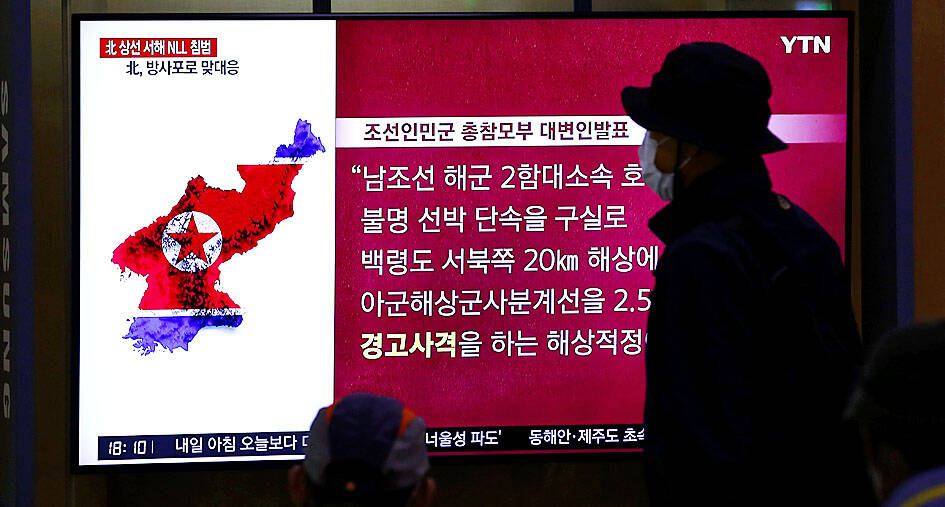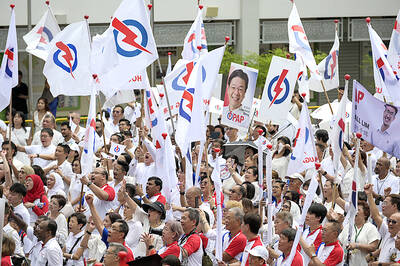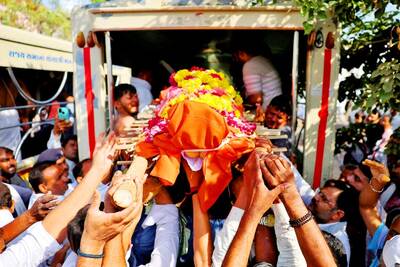North and South Korea yesterday exchanged warning shots along their disputed western sea boundary, raising concern of possible clashes after North Korea’s recent barrage of weapons tests.
The South’s navy broadcast warnings and fired warning shots to repel a North Korean merchant ship that breached the sea boundary at 3:42am, the South Korean Joint Chiefs of Staff said in a statement.
North Korea’s military said its coastal defense units responded by firing 10 rounds of artillery warning shots toward its territorial waters, where “naval enemy movement was detected.”

Photo: EPA-EFE
It said that a South Korean naval ship intruded into North Korean waters on the pretext of cracking down on an unidentified ship.
There were no reports of fighting, but the sea boundary off the Korean Peninsula’s west coast is a source of long-running animosities. The US-led UN Command drew a boundary at the end of the 1950-1953 Korean War, but North Korea insists upon a boundary that encroaches deeply into waters controlled by the South.
Among the deadly events that have happened in the area are the North’s shelling of a South Korean island and its alleged torpedoing of a South Korean navy ship, both in 2010. The two attacks killed 50 South Koreans.
Cheong Seong-chang, an analyst at the Sejong Institute in South Korea, said its was likely that North Korea had intentionally plotted its ship incursion, because it would be “unimaginable” for a North Korean merchant ship to cross the boundary that early in a day without the permission of the North’s military.
North Korea is increasingly emboldened by its recent missile tests, Cheong said.
Pyongyang would also know that Washington’s strained relationships with Russia and China make it more difficult for the US cooperate with the two regional powers on the North Korean issue, he said.
“The South Korean military needs to make thorough preparations to prevent fresh skirmishes from happening on the West Sea and prevent them from causing the worst case scenario like the North Korean military’s artillery bombardments” on a South Korean border island, Cheong said.
The South Korean Joint Chiefs of Staff said the North’s artillery firings yesterday breached a 2018 inter-Korean accord on reducing military animosity and undermined stability on the Korean Peninsula.
It said the North Korean shells did not land in the South’s waters, but South Korea is boosting its military readiness.
The General Staff of the North’s Korean People’s Army said in a statement that South Korea provoked animosity near their land border with its own artillery tests and propaganda loudspeaker broadcasts.
Seoul has confirmed that it fired artillery last week as part of its regular military exercises, but denied that it resumed the loudspeaker broadcasts that both Koreas halted under a 2018 agreement.

ECONOMIC WORRIES: The ruling PAP faces voters amid concerns that the city-state faces the possibility of a recession and job losses amid Washington’s tariffs Singapore yesterday finalized contestants for its general election on Saturday next week, with the ruling People’s Action Party (PAP) fielding 32 new candidates in the biggest refresh of the party that has ruled the city-state since independence in 1965. The move follows a pledge by Singaporean Prime Minister Lawrence Wong (黃循財), who took office last year and assumed the PAP leadership, to “bring in new blood, new ideas and new energy” to steer the country of 6 million people. His latest shake-up beats that of predecessors Lee Hsien Loong (李顯龍) and Goh Chok Tong (吳作棟), who replaced 24 and 11 politicians respectively

Archeologists in Peru on Thursday said they found the 5,000-year-old remains of a noblewoman at the sacred city of Caral, revealing the important role played by women in the oldest center of civilization in the Americas. “What has been discovered corresponds to a woman who apparently had elevated status, an elite woman,” archeologist David Palomino said. The mummy was found in Aspero, a sacred site within the city of Caral that was a garbage dump for more than 30 years until becoming an archeological site in the 1990s. Palomino said the carefully preserved remains, dating to 3,000BC, contained skin, part of the

Russian hackers last year targeted a Dutch public facility in the first such an attack on the lowlands country’s infrastructure, its military intelligence services said on Monday. The Netherlands remained an “interesting target country” for Moscow due to its ongoing support for Ukraine, its Hague-based international organizations, high-tech industries and harbors such as Rotterdam, the Dutch Military Intelligence and Security Service (MIVD) said in its yearly report. Last year, the MIVD “saw a Russian hacker group carry out a cyberattack against the digital control system of a public facility in the Netherlands,” MIVD Director Vice Admiral Peter Reesink said in the 52-page

‘WATER WARFARE’: A Pakistani official called India’s suspension of a 65-year-old treaty on the sharing of waters from the Indus River ‘a cowardly, illegal move’ Pakistan yesterday canceled visas for Indian nationals, closed its airspace for all Indian-owned or operated airlines, and suspended all trade with India, including to and from any third country. The retaliatory measures follow India’s decision to suspend visas for Pakistani nationals in the aftermath of a deadly attack by shooters in Kashmir that killed 26 people, mostly tourists. The rare attack on civilians shocked and outraged India and prompted calls for action against their country’s archenemy, Pakistan. New Delhi did not publicly produce evidence connecting the attack to its neighbor, but said it had “cross-border” links to Pakistan. Pakistan denied any connection to